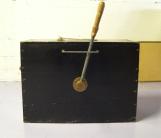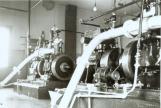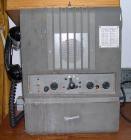40
Front of manual fog horn at Point Atkinson Lighthouse.2004
Point Atkinson, West Vancouver, British Columbia, Canada

41
Side of manual fog horn used at Point Atkinson Lighthouse.2004
Point Atkinson, West Vancouver, British Columbia, Canada

42
Petters diesel engines.1950
Point Atkinson, West Vancouver, British Columbia, Canada
 Credits:
Credits:Courtesy of Norm Dawe
43
Norm Dawe remembers:Whatever you could fix, you would fix it yourself. It was very seldom that you actually brought in help…. Like with the old gas engines, they were forever throwing bearings, so you would have strip your engine down and actually pour a new bearing. In this day and age, this is just unheard of; you would just get a replacement. You would get one engine running again and then the other … would break down, so during the foggy season, it was pretty much continuous. They weren't the most reliable. In those days too, there was a lot more fog than there is today. You can't judge the fog today with say in the '30s. There were beehive burners all over the place: every home in Vancouver, Victoria, Nanaimo. They were all heated with coal, wood, sawdust. All those particles go into the air and little bit of moisture and then you would have fog. And there would be fog solid for a week…fall, spring, summer…
44
Air chimes replaced the diaphone foghorn in 1974. The air chimes were two horns, one for the long note, which was followed by a shorter blast at a lower pitch. An automatic fog-detecting device called a videograph triggered them. The fog alarm system was discontinued in 1997, when the light was automated.45
RadiosPoint Atkinson was outfitted with a radio beacon in 1935. Radios used for navigation rely on the principle of triangulation. An automatic signal was sent out at regular intervals and in foggy weather; it was synchronized with the foghorn. Like the foghorn, the radio beacon was removed in 1996, when the lighthouse was automated.
47
On 28 September 1935, Dawe stood by in the radio room as technicians threw the switch which heralded Point Atkinson's entry into a new world of navigation technology. A radio beacon broadcast a signal synchronized with the fog horns which sliced through the fog and enabled vessels with receivers to pick up Point Atkinson well beyond the range of its light and horns.- From Don Graham, Keepers of the Light, 1985, p. 74.
49
Norm Dawe explained how the radio beacon worked: The radio beacon was a navigational aid. The ships could get their position by tuning into the radio beacon. It was a transmitted signal. In routine transmission in clear weather, they would run for nine minutes on the hour and then nine minutes on the half hour. Then, in fog, it would continue the same, and at the same time the horn would give a short and a long blast, synchronized. So the mariner could listen to the sound of the radio beacon, and then get the time difference between that and hearing the horn and get those in seconds and divide that by 5.5 and they would get their distance off the light in miles. The beacon was automatic. It ran on a 32-volt system and it had its own little generators. They were Koeller electric plants.50
Laying telephone cable to Point Grey.1936
Point Atkinson, West Vancouver, British Columbia, Canada

51
In the late [19]40's, a lighthouse radio telephone service was established on 1792 kHz. For the first time many of these stations, which formerly only had contact with the outside world via their quarterly supply vessel, now had daily communication with the nearest coast station. Later, in the [19]60's, this service was replaced the by the B.C. Telephone Co., which contracted to provide a VHF radio telephone service to all west coast lighthouses.- From Larry L. Reid, The Story of the West Coast Radio Service, 1906-1956. With a foreword by J. Farrell Hopwood (Vancouver, BC?: Larry L. Reid and Chameleon Publishing Co., 1992, p. 76).
52
Jean Odlum remembers the radio: Because of the war situation, you were not allowed to use the radio. After the war calmed down, we could use the radio. The department supplied some funny looking set, the frequency was set and you couldn't move it. We used to call it a lot of things. But that was all you could get, was that one frequency.53
Weather monitoringLighthouses play an important role in providing data for weather collection. Weather information has been gathered at Point Atkinson since light keepers have been there. Early reports were kept in station logbooks and were based on regular observations.
Specific equipment was later added to record wind speed and direction, precipitation and temperature. The data from light houses is gathered and reported by the Atmospheric Environment Service in daily, monthly and annual summaries. The summaries are used to track changes in weather elements over long periods of time, and for climatic, hydrologic and agricultural planning and research. Today, weather recording systems are automated.

